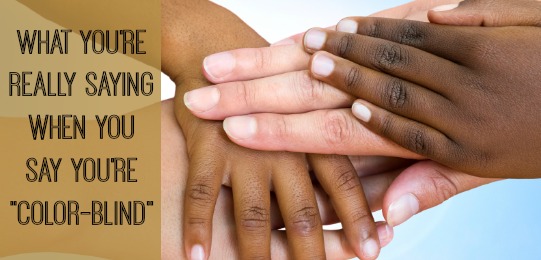
What People *Really* Mean When They Say They're Racially "Color-Blind"
Every time racial issues arise, parents like you come out of the woodwork. You mean well. You say it on every article about race: “I’m raising my kids to be color-blind,” you insist. “If we just all stopped seeing race everything would be a lot better.”
You believe in America and opportunity and why-can’t-we-all-just-get-along. You judge not-by-the-color-of-their-skin-by-the-content-of-their-character. You deeply, desperately cling to the Lady Liberty lullaby: we are all equal; we all have the same opportunities for life, liberty, and the pursuit of happiness. Color-blindness is an integral part of that belief.
But what you really mean, when you insist on raising your kids to be color-blind, is this: we want to ignore race. And when you ignore race, the default color becomes white. Color-blindness, really, means white-washing.
Black people don’t raise their children to be color-blind. Neither do Hispanic parents or Asian parents. Only white people can claim they want their children “not to see race.” Other parents, you see, don’t have the luxury of ignoring it.
When you teach “color-blindness” you teach your children to discount the stories of the people around them.

Did a black boy say he got yelled at when a white kid got a pass? This incident, you tell your child, is not worth hearing. Color-blindness teaches that this scenario is called “playing the race card,” and it means you should ignore the voice telling it. It insinuates the speaker wants special privileges because of his non-existent racial oppression. It tells your child that speaker is angry and not worth listening to.
Color-blindness asks why we need a Black History Month. It asks why we don’t have a White History Month, because everyone is equal.
Color-blindness dresses kindergarteners in construction-paper feathers on Thanksgiving. It accepts Columbus Day as a holiday about intrepid exploring and discovery and forgets those who were victims of genocide as a result.
Color-blindness fails to question the mass-media images of beauty: the thin, the white, the long straight hair and perky nose. Color-blindness asks black girls why their cornrows look like worms; it sees afros as a threat. It insists Native American kindergarteners cut their hair.
Color-blindness hands black girls blond-haired Barbies.
Color-blindness demands to end affirmative action – after all, everyone in America has an equal chance to make something of themselves and any historical inequality has been long-corrected. It resents children of historical minorities “taking spots” from white children.
Color-blindess thinks black kids can’t sunburn.
Color-blindness makes children’s shows populated with generic white children.
Color-blindness sees Jesus and ancient Egyptians as some kind of proto-white people – or at least, colors them only lightly tanned.
Color-blindness tells their children their favorite platitude of the old: there are white people and white trash, and there are black people and n*ggers.
Color-blindness isn’t just an act of violence against people of color. It’s a deliberate white-washing, a deliberate eye-closing. It’s not blindness: blindness is involuntary. Color-blindness is a mask. It sees white people as the default color, the default culture, and the default arbiters of the world we move through. When we teach our kids to be color-blind, we ignore history. We ignore injustice.
And most of all, we ignore the lives of the real people around us.
A mama to three sons, 4 and under, Elizabeth dropped out of academia to procreate and spend way too much time tie-dying. A certified educator with Babywearing International, she still misses teaching freshman English. Elizabeth practices attachment parenting out of sheer laziness, and writes about social justice and crunchy parenting at Manic Pixie Dream Mama. Her work has appeared on the Huffington Post, xojane, Mamapedia, Today Show Parents, and Time.com.